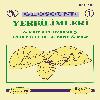The effect of temperature on the geochemical composition of the valves of the ostracod species Krithe praetexta praetexta
The effect of temperature on the geochemical composition of the valves of the ostracod species Krithe praetexta praetexta
The present study aims at deciphering any possible relationship that"- may exist between temperature and the following gepchemical signals: MgCa-, SrCa-, Na/Ca ratios,$delta$13C and $delta$13C in the valves of living representatives of the marine, infaunal ostracod species Krithe praetexta praetexta (Sars, 1866) grown under constant temperatures of 5, 10 and 14°C . Calibration curves for temperature versus MgICa ratios estimated for each thermoculture differ from the previously established calibration curves of these two parameters on deep-sea representatives of the genus Krithe. Nevertheless, the MgICa ratios of the adults ofK. praetexta praetexta from the three cultures overlap somewhat with the scatter of earlier estimations of MgICa ratios of deep sea representatives of the genus Krithe within the range of 5 and 14°C The wide scatter of the MgICa ratio of individual specimens within the various cultures query the previously obtained strong correlation between temperature and the MgICa ratio of ostracods and suggest that factors other than temperature may play a role in the uptake of Mg by ostracod valves. There is less scatter for the SrICa ratio of individual ostracods within each thermoculture. The calibration curve established between temperature and the SrCa ratio of individual ostracod valves from the various thermocultures is highly significant for both adults and A-l juveniles of K. praetexta praetexta. However, we cannot rule out any effect from eventual variation in the SrICa ratio (or the Sr content) of the host water in the various thermocultures. A positive correlation is discernible between the MgICa and SrICa ratios of K. praetexta praetexta in the present experiment. Thus, if there is a positive correlation between temperature and the MgICa ratio in K. praetexta praetexta, then the SrCa variation in K. praetexta praetexta could be indirectly related to temperature just as previously noted for the freshwaterostracod Candona rawsoni. There is no correlation between temperature and the NaICa ratio of the A-l juveniles; possibly the variation in the NaICa ratio of the valves in the various thermocultures (and aquaria) is a consequence of variation in salinity of the sea water during the course of the eperiment. The oxygen isotope fractionation was determined for ostracod valves of the various thermocultures and show that the adults grown in the cultures show an enrichment in 818O.within the ranges of 0.57-1.14 (5°C), 0.73-1.30 (10°C ) and 0.76-1.96%o (14°C). The A-l juveniles of the 5°C culture calcified close to isotopic equilibrium, whereas the A-l juveniles of the 14°C culture displayed a 0.5-1.5%o enrichment in 8^0. The $delta$13C ofK. praetexta praetexta shows a positive correlation with temperature for both adults and the A-l juveniles. We speculate that this results from the life habit of this infaunal species or is due to a positive relationship between temperature and the 1&-3Q of the porewater of the sediment. Alternatively, seasonal variation in salinity might explain differences in $delta$13C ofcalcite shells.
